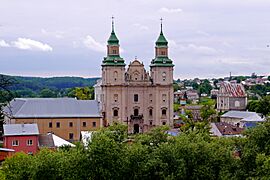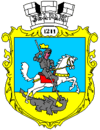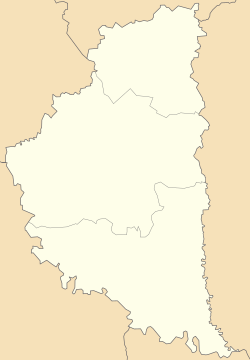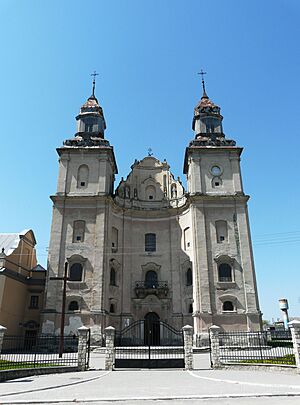Zbarazh facts for kids
Quick facts for kids
Zbarazh
Збараж
|
||
|---|---|---|
|
||
|
||
| Country | ||
| Oblast | Ternopil Oblast | |
| Raion | Ternopil Raion | |
| Hromada | Zbarazh urban hromada | |
| First mentioned | 1211 | |
| Area | ||
| • Total | 7 km2 (3 sq mi) | |
| Population
(2022)
|
||
| • Total | 13,346 | |
| • Density | 1,910/km2 (4,900/sq mi) | |
| Time zone | UTC+2 (EET) | |
| • Summer (DST) | UTC+3 (EEST) | |
Zbarazh is a city in western Ukraine. It is located in the Ternopil Oblast region. Zbarazh is part of the historic area called Galicia. About 13,346 people live there.
Zbarazh is famous because it was a setting in the novel With Fire and Sword. This book was written by Henryk Sienkiewicz in 1884. It describes a famous event called the Siege of Zbarazh. Many important people have lived in Zbarazh, including Rabbi Zev Wolf of Zbaraz and the writer Ida Fink.
Contents
History of Zbarazh
Early Beginnings
Zbarazh was first mentioned in 1211. Back then, it was a strong fortress in the Ruthenian lands. By the late 1300s, it became the home of the Zbaraski princes. You can still see parts of the old castle near modern Zbarazh today.
Changes in Control
In 1569, Zbarazh became part of the Kingdom of Poland. This happened after the Union of Lublin. Later, in 1772, the town was taken over by the Habsburg monarchy. It remained in the region of Galicia until 1918.
After World War I, there was a conflict between Poles and Ukrainians. Zbarazh then became part of Poland again. It was the main town of a county in the Tarnopol Voivodeship. Between the World Wars, Zbarazh had about 8,000 people. This included Jewish, Polish, and Ukrainian communities.
World War II and Beyond
German forces took control of Zbarazh on July 4, 1941. Before they fully set up their rule, some local groups caused violence. Many Jewish people were killed, and synagogues were burned. Soviet prisoners of war also lost their lives.
By the time of the German invasion, the Jewish population had grown to about 5,000. This was because refugees from western Poland came to Zbarazh. Later in 1941, about 70 Jewish people were killed in the Lubianka Forest. In 1942, around 3,000 Jewish people were sent from Zbarazh to the Belzec camp. This happened several times.
A ghetto was set up for about 2,000 Jewish people from Zbarazh and nearby areas. Many people shared small rooms. In November, another 1,000 Jewish people were sent to Belzec. During the winter of 1942-43, many died from hunger and sickness. Others were forced into labor camps.
In April 1943, another 1,000 Jewish people were killed near the Zbarazh railway station. In June, the remaining few hundred Jewish people were also killed. After this, German and Ukrainian police searched for those hiding in forests. Only about 60 Jewish people from Zbarazh survived out of the 3,000 who lived there before the war.
After World War II, the Soviet Union took over Zbarazh. Polish residents were told to move to other areas. The town then became part of Ukraine.
Recent Changes
Until July 18, 2020, Zbarazh was the main center for the Zbarazh Raion. This area was changed in July 2020. The number of regions in Ternopil Oblast was reduced. Zbarazh was then moved to the Ternopil Raion.
Points of Interest in Zbarazh
The Zbarazh Castle
For many years, Zbarazh was the main place for the Zbaraski family. When their family line ended, the town went to the Wiśniowiecki family. It also belonged to the Potocki family.
The new Zbarazh Castle was built for Prince Jeremi Wiśniowiecki. It was designed by a Dutch architect named van Peyen. The building took place from 1626 to 1631. The castle was partly rebuilt in the 1700s. A palace built for the family is also in the nearby town of Vyshnivets.
Churches and Monasteries
Zbarazh has several amazing churches. These include the Saviour Church, built around 1600. There is also the Bernardine Monastery, built in 1627.
The Zbarazh Fortress was attacked twice by the Crimean Tatars. This happened in 1474 and 1589. After the second attack, a new castle was finished in 1626. In 1649, during the Khmelnytsky Uprising, the castle was attacked again. Cossacks and their Tatar allies besieged it. Polish troops, led by Jeremi Wiśniowiecki, defended it for 43 days. The castle was not captured.
The local Roman Catholic church was built in the mid-1600s. It was funded by Janusz Wisniowiecki. The Ottoman Turks destroyed it in 1675. It was rebuilt in 1755, along with a new monastery. Inside the church, there was a special plaque. It honored the 100th birthday of Adam Mickiewicz.
Between the World Wars, Bernardine monks ran a middle school here. The church and monastery were not destroyed during World War II. The monastery was used as a hospital, then a factory. The church became a warehouse. Some items from the church were saved by Polish residents. They took them to Poland in 1945. These items are now in Bernardine churches in Leżajsk, Rzeszów, and Alwernia.
After the end of the Communist period, the church was given back to the monks. The first service was held on September 3, 2000.
Notable People from Zbarazh
- Ignacy Daszyński (1886–1936), a Polish politician.
- Ida Fink (1921–2011), an Israeli-Polish writer.
- Meshullam Feivush Heller (c. 1742–1794), a Hasidic author.
- Dmytro Klyachkivsky (1911–1945), a Ukrainian Insurgent Army commander.
- Karol Kuryluk (1910–1967), a Polish social activist.
- Ivan Prasko (1914–2001), a Ukrainian-Australian Greek-Catholic bishop.
- Zev Wolf of Zbaraz (died 1822), a rabbi.
- Velvel Zbarjer (1824–1884), a famous singer.
- Serhiy Prytula (born 1981), a Ukrainian TV host and political activist. He founded the Charity Foundation of Serhiy Prytula.
Gallery
See also
 In Spanish: Zbárazh para niños
In Spanish: Zbárazh para niños















